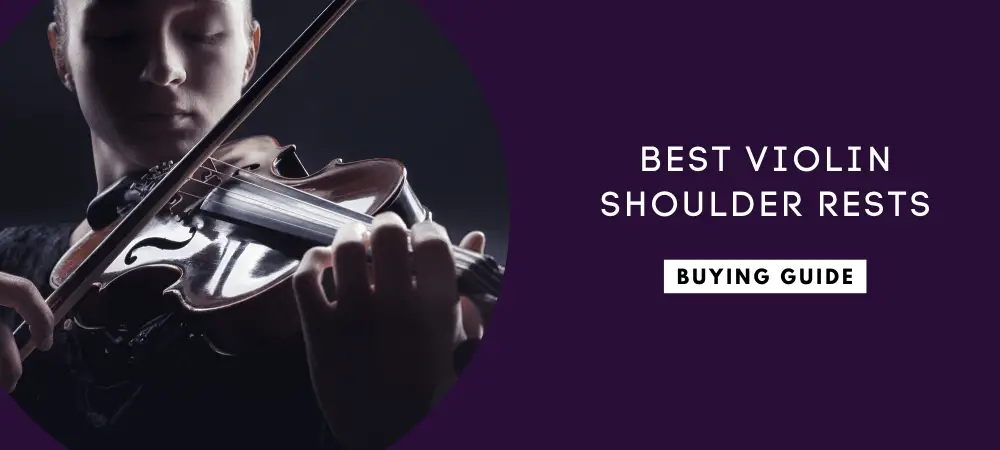The issue of violin shoulder rests is quite a contentious one.
Some believe that a player must never use a shoulder rest while others insist that it is impossible to play without one.
So which school of through do you abide by?
The choice to use or not use a shoulder rest is highly personal, and since you’re here, I reckon you do use shoulder rests, or at least are considering to get one.
In that case, how do you go about finding the perfect violin shoulder rest for your style of play and one which perfectly suits the length of your neck?
Well, let’s find out.
Table of Contents
Best Violin Shoulder Rests In 2024 Reviewed
The highlight of this violin shoulder rest is the collapsible feet, which allow you to store the shoulder rest in your violin case conveniently.
At the same time, the high-grip feet are height adjustable, and this allows for a better-personalized fit.
The beautifully crafted solid maple wood body is extremely durable and provides a warm resonance against your violin.
The wood base is covered with premium foam padding that ensures the player remains comfortable even during extended play.
- Lightweight.
- Sturdy construction.
- Height is adjustable.
- Has collapsible feet.
- Comfortable for both right and left-handed players.
- The feet fall off quite often.
Kun shoulder rests are overwhelmingly preferred by players worldwide and for a good reason.
This particular rest has a good amount of adjustability. The player can adjust the location of the fit, the height of the feet, and the angle of the feet.
Quite impressive, don’t you agree?
As a result of the three-directional adjustability, this rest can fit players with a variety of body shapes, regardless of what one’s preferences are.
At the same time, this shoulder rest comes with a fair amount of padding on the beam, which further enhances comfort.
There is no exposed metal on the feet, so you don’t have to worry about scratching your cherished instrument while using this shoulder rest.
- Impressive adjustability.
- Easy to assemble.
- Sturdy construction.
- Lightweight.
- Comfortable.
- The feet aren’t collapsible.
This Bonmusica violin shoulder rest is another impressively adjustable model.
With this rest, you could adjust the gadget’s height, width, and curve.
As a result, the player can obtain a precise fit while the rest remains as comfortable as possible.
The foam padding on the base is highly resistant to wear and tear, not to mention that it is incredibly comfortable as well.
If you are looking for a rest that allows for hands-free stability of your violin, then this Bonmusica rest is just what you need.
- Solid, sturdy construction.
- Left-handed players can use it.
- Completely adjustable.
- Bendable base design.
- Doesn’t muffle the violin’s sound.
- The padding is relatively thin.
The highly polished finish of this violin shoulder rest will certainly catch your eye.
Constructed from maple wood, the natural wood grain of this rest will beautifully complement your instrument.
Aesthetics aside, this gadget functions just as beautifully.
The smoothly worked curve of the rest will contour seamlessly to your shoulder, providing an excellent fit for ultimate comfort.
On the backside of the wooden base, there is a thin layer of high-density foam, which further enhances the comfort of the instrument.
The non-slip feet are height adjustable. You simply screw them in and out to tweak their height to your liking.
To conform to both a 3/4 and a 4/4 violin, this rest comes with peg holes, which allow you to widen the fit as desired.
- It can fit both a 3/4 and a 4/4 violin.
- Height adjustable feet.
- Sturdy solid wood construction.
- Gives a warm resonance.
- Collapsible feet for easy storage.
- The padding is a little too thin.
This incredibly lightweight violin shoulder rest weighs a mere 2 ounces.
This is made possible by the fact that the rest is built from a carbon/polymer composite that’s incredibly light yet very strong.
The rest has a sleek, streamlined look that’s suitable for use by players with a short neck.
The height-adjustable feet of this shoulder rest are durable and provide a nice secure fit.
You don’t have to worry about the feet slipping off during a performance.
Neither do you have to worry about the feet scratching your violin.
- Sleek lightweight design.
- Sturdy and durable construction.
- Height adjustable feet.
- Comfortable contoured design.
- 1-year warranty.
- Doesn’t have the warm resonance of wood rests.
Wolf is a long-established Dutch company known for its high-quality violin shoulder rests that are also versatile and reasonably priced.
When it comes to the Wolf Forte Primo, the height can be adjusted from 1.25” to a full 3.25”.
This allows for versatility as the rest can be used by players of various body shapes and neck lengths.
In addition to the height, the pitch of this rest is also adjustable using the swiveling legs.
The aluminum metal base of this rest has a foam rubber strip, and this can be bent to provide a customized fit for a particular player’s shoulder.
At the same time, the padding is very comfortable as well.
- It is durably built.
- Very lightweight.
- Adjustable height and pitch.
- Bendable design.
- Very stable, even in the highest position.
- The rubber feet don’t grab the violin very well.
Introduced in 1994, the Kun Collapsible was modeled on the Kun Original; hence you might notice that the two rests appear to look very similar.
The most significant difference is that this particular model is – as you might have guessed – collapsible.
The ends of the shoulder rest are designed to fold down, therefore, allowing for easy storage in a violin case.
At the same time, the feet on this gadget feature Kun’s patented locking device.
This mechanism ensures that the rest will not touch the violin, thereby limiting rotation while you play.
The rubber-encased metal feet make use of a strong elastomer that guarantees a firm grip on the instrument so that you won’t have issues of the rest slipping off the violin.
- Strong thermoplastic frame.
- Soft, firm-gripping rubber-encased feet.
- Collapsible design.
- Foam padded for comfort.
- Fully adjustable for height, width, and pitch.
- The profile isn’t bendable.
Everest is a brand known to employ the finest materials and workmanship in the manufacturing of their violin shoulder rests.
The Everest EZ4A model is very popular, perhaps because it is a high-quality rest that’s very affordably priced.
This virtually indestructible violin shoulder rest is made from ABS and comes in a variety of striking colors.
The padding is made from neoprene foam.
Besides its durability, this rest is also very comfortable since it’s been ergonomically designed.
The rest has a fixed tilt, but the height and width are both adjustable, thereby allowing for a versatile fit.
Additionally, the feet are made from patent-pending grippers, which are wear-resistant and guard against slippage.
- Low-cost.
- Extremely durable construction.
- Comfortable ergonomic design.
- Adjustable height and width.
- Grips the violin very firmly.
- Not ideal for use by left-handed players.
The high-density composite construction used for the base of this shoulder rest allows for maximum strength of the gadget along with impressive durability.
Furthermore, this Portland shoulder rest has solid metal brackets that are not only sturdy but are also adjustable for a more personalized fit.
The feet of this rest are made from steel, covered with molded rubber that grips the instrument firmly.
At the same time, the feet can adjust in any direction to provide a secure fit on the violin.
- Sturdy and durable construction.
- Ergonomic curvature.
- Great adjustability.
- Solid, high-quality hardware.
- 1-year warranty.
- It might be too high for some players.
Now, why don’t we end this list with a beginner-friendly violin shoulder rest?
Designed for 1/4 size violin, this rest can be adjusted to fit 1/8, 1/10, and 1/16 sized violins.
This feature makes it ideal for younger players because the rest ‘grows’ with them, without requiring you to buy a new rest every time they shift to a bigger violin.
This CuSteam shoulder rest has a sturdy, high-quality resin base, covered on one side with a high elastic EVA pad.
The feet on this rest are collapsible and have silica get on the feet pad, thereby providing good traction while keeping your instrument scratch-free.
The feet are adjustable as well, allowing you to make changes to the height or the angle of the rest, as you attempt to find the perfect setup that suits your style of play.
- It is constructed from high-performance materials.
- Adjustable height and angle.
- Collapsible silicone-coated feet.
- Comes with rosin.
- Perfect for younger players.
- It cannot fit a full-size violin.
Should I Use A Shoulder Rest for Violin?
Before deciding to play with or without a shoulder rest, you need to have thoroughly analyzed your style of play as well as your physique or body shape.
- Do you have a particularly long neck such that there is a considerable distance between your jaw and collarbone?
- Do you find that you have to lift your shoulder while playing?
- Do you find that you have to lower your chin to ‘clench’ the violin while paying?
- Does the violin always slip off your shoulder, so you struggle to make it stay put?
- Do you get uncomfortable playing the violin for long durations?
- Do you struggle with balancing the violin while shifting?
- Does it appear impossible for you to do an effective vibrato?
If you answered ‘yes’ to any or all of the above questions, then there is a good chance you might be better off with a violin shoulder rest.
The whole idea behind a shoulder rest is to help the player maintain a comfortable and relaxed playing posture. This not only prevents muscle pains, strains, and injuries but also enables you to play better.
By elevating the violin off your clothes and collarbone, a shoulder rest allows for more freedom of movement, and this can allow for the violin’s authentic sound to emerge.
Ultimately, keep in mind that there is no general yes or no reply when it comes to helping you decide on whether you need a shoulder rest. Some fantastic players swear by a shoulder rest, while others play marvelously without one.
If, after assessing your style of play, you conclude that you might need one, then give it a try and see how it goes. If you find that a rest is the way for you, then unapologetically keep playing with it.
There’s absolutely nothing wrong with using a shoulder rest to enhance your violin playing experience. Neither is there anything wrong with not using if you don’t need to.
Comfort is all you should be concerned about.
Violin Shoulder Rest Types
A shoulder rest is designed to attach to the violin, to provide stability and comfort while playing. These rests come in different shapes and sizes: soft vs. hard, adjustable vs. rigid, etc., meaning there are very many types of shoulder rests to choose from.
1). Clip-On (Bar-Style) Shoulder Rest
By far the most popular type of shoulder rest, this ergonomically-shaped design comes with ‘feet’ on either side of the rest. The feet are designed to attach to the rim of the violin, and they are adjustable in terms of height, width, and angle.
2). Foam Shoulder Rest
It comes in the form of a cushioned block that’s been indented at the center, thereby contouring to the shape of the shoulder. This rest is easy to put on and feels very soft against the body.
3). Stick-On Shoulder Pads
These are essentially, small round pads or sponges that self-adhere to the back of the violin.
Beginners or younger players typically use this style of shoulder rest. Because there is no glue or clamps involved in attaching the pad to the violin, the player doesn’t run the risk of accidentally damaging the instrument.
4). Air Cushion Shoulder Rest
This shoulder rest design comes in the form of an inflatable cushion that straps to the back of the violin.
Things to Consider When Buying A Shoulder Rest for Violin
Materials
The material used to make a shoulder rest may affect both your comfort and the sound output of your violin. Just as well, the material choice will also dictate the pricing of the rest.
a). Wood
Wooden shoulder rests have become quite popular of late. The commonly used types of wood are maple, walnut, and ash. Ash is tough and resilient, and as a result, this material tends to produce a clearer tone from your violin.
Well, hard materials, in general, are better for the violin’s sound output.
Wooden rests are unrestrictive, strong, durable, provide good resonance, and have a stylish appearance that matches the violin’s design.
On the downside, wooden rests cannot be bent to fit the shape of your shoulder. As a result, they could be pretty uncomfortable, necessitating you to include some sponge or padding on the bottom for better fit and comfort.
b). Plastic
Plastic rests are a lightweight, inexpensive option. They are also available in a wide range of colors so you can find something that uniquely expresses your personal style.
Because plastic is malleable, most rests can be bent slightly by hand, to provide a better fit. As for comfort, plastic shoulder rests often come padded with soft plastic foam.
The disadvantage of this kind of rest is that the lightness of the material could alter the tone of your violin. At the same time, cheap plastic rests don’t tend to last very long.
c). Carbon fiber
Carbon fiber shoulder rests have an appealing sleek design. These rigid rests are also extremely lightweight and incredibly durable.
d). Metal
Some shoulder rests may employ metals in the construction of the beam, i.e., the part that touches your shoulder.
Metal is preferred for its rigidity, and in some instances where soft bendable metal has been used, you could even mold the rest to fit your shoulder. This bendability allows for personalized fit and comfort, which many players seem to prefer.
e). Hardened Rubber
Rubber is often used for the feet of the shoulder rests to ensure that the violin surface won’t get scratched or marked. However, some rests may also be made entirely from hardened rubber.
Rubber rests are flexible and affordable. On the downside, however, they are not as stylish as their wood or carbon fiber counterparts.
f). Foam or Sponge
Because of their soft nature, foam and sponge rests are usually very comfortable, and the padding can be as thick or as thin as you desire.
On the downside, the soft material tends to absorb vibrations from the violin, therefore interfering with the sound output by muting the instrument. This is especially so when the foam or sponge padding touches a large surface area on the violin.
Therefore, when using a foam violin shoulder rest, you may find that the violin sounds softer owing to the lower amplitude.
Shape & Size
Finding the perfect violin shoulder rest isn’t just about finding the perfect height. The shape of the rest matters as well.
The ergonomics of a shoulder rest is an essential factor to take into consideration, especially if you are looking at rigid rests that cannot be bent to provide a better fit. At the same time, consider the size: would you like a large rest or a smaller one?
A shoulder rest should help you hold the violin more comfortably, so it would beat the entire purpose of one if you got an uncomfortable one. However, it is worth noting that the comfort of a violin might not entirely lie on the shoulder rest. The chin rest should be factored in as well.
So, the best thing to do is to take your violin with you when you go shopping for a shoulder rest. This context will help you make a better decision than if you were simply to try out shoulder rests on their own.
A shoulder rest that’s the wrong shape or size will keep pushing the instrument from under your jaw. So, when this happens, you need to find out whether this is as a result of the wrong shoulder rest height or if you might need a different chinrest shape.
Adjustability
Modern technology has made it easier to deal with the size of your violin as you deem desirable. This is because most shoulder rests are fully adjustable, allowing you to tweak the rest’s height until it provides a perfect fit for both you and your violin.
Almost all shoulder rests in the market will allow you to adjust the gadget’s depth and height. Additionally, other rests may also come with a tilt or swivel feature that adjusts the angle of the base.
Still, on adjustability, some bendable models can be curved to the shape of your shoulder.
Durability
The shoulder rest you invest in obviously needs to withstand the test of time, thereby guaranteeing you your money’s worth.
To see whether the rest is durably built, you first need to check that the locking mechanism is sturdy and easy to use. The locking mechanism should be able to stand up well to the hundreds of times you’ll attach and detach it from the violin.
With a high quality, durable violin shoulder rest, you should never have to worry about damaging the gadget due to frequent installation and removal.
Additionally, the feet of the rest should be constructed from soft material that won’t scratch your cherished instrument. Soft feet would be gentle on the violin, without compromising the clamp’s firmness when attached.
Overall, one of the greatest assurances of quality build and durability is to invest in reputable brands. Reputable brands are reputable for a reason. They have spent a ton of time, research, and other resources to ensure their product are up to par.
This is not to mean that lesser-known companies always have inferior quality products. Dealing with a reputable company is simply a safer bet if you’re ever in doubt.
FAQs About Best Violin Shoulder Rests
Is Playing the Violin Bad for Your Neck?
No, it’s not.
A vital part of learning how to play the violin involves developing correct form and the proper playing techniques as well. As a result, playing the violin shouldn’t hurt your hand, back, arm, or neck.
If you find that you do experience pain and discomfort while playing, then this may be caused by changes in technique, practice habits, improper instrument setup, or incorrect posture.
Of all these, incorrect posture is usually the major culprit. Developing proper posture early enough and maintaining it every time you play or practice will play a huge role in keeping pains at bay.
How do you know whether you are using the correct posture? Well, here are a few guidelines:
- Your head should be straight and not tilted to one side.
- Bring the violin to your body; don’t bring your body to the violin.
- Your posture should feel relaxed and fluid.
If you find that you are bending your head after playing for a considerable amount of time, get up and stretch your neck muscles. Even if you do adopt the proper posture, taking regular breaks is mandatory, especially during intense practice sessions.
If you find that you have the right posture and are using the correct technique yet your neck still hurts, then maybe it’s time to think about your setup i.e., the chin rest and shoulder rest.
Best Violin Shoulder Rest for Long Neck
The Wolf Forte Primo violin shoulder rest can be adjusted to a full height of 3-1/4”, making it ideal for players with, particularly long necks. Just as well, the rest comes with two plastic spacing tubes that allow the arms to remain stable even when adjusted to the highest position.
Portland Gold violin shoulder rest would be another acceptable option for long-necked players. This fine-looking shoulder rest is constructed using high-quality material so the player can get good value for money.
Best Violin Shoulder Rest for Short Neck
The Everest EZ4A violin shoulder rest is a low-cost shoulder rest that’s very comfortable and is virtually indestructible as well. The gadget allows the player to adjust both the height and the width to get a perfect fit.
You may also try out the Fiddlerman light carbon fiber shoulder rest that’s very lightweight and suitable for use by players with shorter necks.
Why Does My Left Shoulder Hurt When I Play Violin?
1). You’re lifting your shoulder while playing.
Playing the violin should involve moving your elbow and upper arm, while your shoulder remains relaxed. If you find that you are lifting your shoulder towards the ear, during string changes, then this is the wrong form and will cause a lot of pain in the long run.
Resist the urge to lift your shoulder while playing. Instead, push your shoulder down, relaxing your muscles, and let your hand hang heavily while playing.
2). Your shoulder rest is too high.
Initially, you may feel comfortable playing with a high shoulder rest, but playing with such a rest isn’t advisable. See, the higher the rest is, the higher you’d have to lift your bow arm. In turn, this would cause pain and tension in the shoulders.
If you would prefer a higher rest for your chin, then consider adjusting the chin rest, not the shoulder rest.
3). You play continuously for extended periods.
Even if you have the correct posture and are using the perfect playing technique, it is inevitable for your shoulder to hurt after playing for too long. This is normal, and it is known as repetitive strain injury.
Being a typical and expected side effect of playing the violin for extended hours, there are things you can do to alleviate the pain incurred. Always take breaks between sessions, and while resting on those breaks, attempt to do some shoulder stretching exercises.
4). Improper bow hold
You hold your bow in the right hand, so how could that translate into a pain in the left shoulder? Well, allow me to explain. See, we are symmetrical creatures, so discomfort in your left hand could reflect in the left hand as a sympathetic reaction.
The pain in your left shoulder, therefore, could be as a result of over-spreading your fingers in the right hand while holding the bow. Relaxing the right arm could actually alleviate the shoulder pain on your left side.
How Do You Put on A Shoulder Rest?
This is very important, considering that an improperly installed shoulder rest could result in bad form and a lousy bowing angle. Also, you might want to try attaching the rest at different angles so that you can find the one that works best for you.
Conclusion
A shoulder rest is a piece of equipment that’s extremely personal to a player. Finding the perfect one will take time, effort, persistence, and patience as you try out different violin shoulder rests and adjustments.
It might take a good deal of trial and error, but don’t give up too soon.
The ideal shoulder rest should feel comfortable while allowing for flexibility of movement so that you don’t feel restricted while playing.














